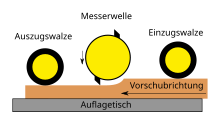Thicknesser
A thickness planer , Thicknesser or short Dickte is a machine tool for cutting wood processing . Its task is the planing of a workpiece to a desired thickness after one or two sides dressed were.
Structure and way of working
The thicknesser has several parts with different functions:
- The planer knife shaft is used for chip removal, it has between 1 or 2 or 4 planer knives. This rotates at 4000 to 9000 rpm in the opposite direction to the feed direction (counter-rotation) of the piece of wood and planes it to the desired thickness. The circumferential and thus the knife speed depends on the shaft diameter.
- There are basically four types of planer knife shaft.
- Wedge knife shaft (standard) 2–4 planer knives
- Reversible knife shaft (easy conversion, the knives can be used on both sides) 2–4 planing knives
- Spiral knife shaft (best surface quality) 1 to 2 planer knives
- Spiral knife shaft with indexable inserts
- The standing housing with a hinged part (mostly made of cast iron) is used to cover and fix the internal components. The hinged part in particular is used to cover the planer shaft, which must also be accessible when changing knives.
- The infeed and outfeed roller conveys the workpiece using contact pressure from above by rotating around its own axis towards the planer shaft. The pull-out shaft pulls the workpiece away from the planer shaft after machining.
- The non-return gripper ensures that in the event of inequalities in the wood e.g. B. branches the cutterblock cannot knock back the workpiece. The non-return gripper is similar to a hinged bracket with toothing that is fastened in front of the feed roller by means of a swivel joint.
- The dressed workpiece is placed on the machine table and fed.
- The table rollers are located in the machine table to make it easier for the workpiece to slide through. The number of table rollers varies from none to several, mostly ball-bearing rollers.
- The two pressure bars press the workpiece against the machine table immediately before and after the cutterblock in order to prevent vertical movements of the workpiece. This improves the surface quality.
- The handwheel is used to adjust the thickness. In modern machines, the handwheel is often replaced by an electric servomotor.
- The suction device transports the planed chips away from the cutterblock by means of negative pressure.
Some manufacturers offer segmented spiral cutterblocks with indexable inserts as special equipment for their machines. Here, individual HW inserts (square basic shape with four main cutting edges) are arranged on the knife shaft in such a way that the cutting edges have a minimal overlap. Due to the effective cutting edge geometry, a good surface quality can be expected even with very difficult material properties. Individual damaged cutting edges can be quickly and efficiently exchanged by turning 90 ° or changing a single insert. However, a complete change of the indexable inserts (depending on the cutterblock width up to 100 indexable inserts) is associated with considerable expenditure of time and costs. Since these are HW indexable inserts, a tool life that is up to 20 times longer than that of HSS knives can be expected. A positive aspect of this cutterblock design is the considerable reduction in noise emissions by approx. 12 dB (A).
Web links
Individual evidence
- ↑ Wolfgang Nutsch and others: expertise for carpenters (12th edition), published by Europa-Lehrmittel, Wuppertal 1980, page 280, ISBN 3-8085-4011-7

